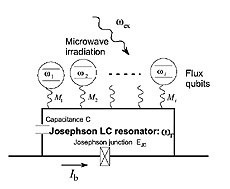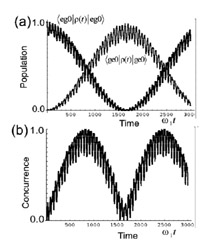1Physical Science Laboratory, 2Tokyo Inst. Tech./NTT Research Professor
A quantum computer is composed of many two-state elements called quantum
bits (qubits). A quantum calculation should be completed within the coherence
time (during which, the quantum superposition is maintained). To achieve
this, two-qubit operations where we can choose two arbitrary qubits from
a large number are advantageous. Moreover, there is a strong need for an
operation that can be performed even if the two qubits are not next to
each other. However, to achieve two-qubit operation, we employ the physical
interaction between the two qubits, therefore performing a qubit operation
on a spatially remote pair is usually very difficult.
We developed a structure and an operating principle to enable such
two-bit operation for superconducting qubit systems, and clarified the
physical characteristics by theoretical analysis (Fig. 1) [1].
Every qubit interacts with the same superconducting resonance circuit
(e.g. an LC circuit or a transmission line), but the resonance frequencies
of individual qubits are sufficiently different to ignore direct interactions
between qubits. We use indirect interaction through this resonance circuit
and realize the function described above.
Assume that a two-bit operation is performed only between a specific
qubit pair (with frequencies of ω1, and ω2). It is important that the resonance frequency ωr can be varied by changing the dc bias-current (Ib) supplied to the Josephson junction in the resonance circuit. When the
resonator frequency is tuned to ωr〜(ω1 + ω2)/2 and a microwave with the frequency ωex〜(ω2 − ω1)/2 is applied from the outside, the two qubits are operated without affecting
a state of a resonance circuit via a two-photon Rabi process. This means
that it is possible to operate two qubits that do not interact directly.
Because only a qubit pair that simultaneously satisfies the two above
ωr and ωex conditions can react, we can choose two of specified qubits by tuning
the resonator and the microwave (Fig. 2). In addition, this enables the
two-bit operation of spatially longer-distance remote qubits because the
resonance circuit can be 1 mm for an LC circuit [2], or more for a transmission
line. This work was partially supported by CREST-JST, JSPS-KAKENHI (18201018,
18001002).
[1] H. Nakano, K. Kakuyanagi, M. Ueda, and K. Semba, Appl. Phys. Lett.
91 (2007) 032501.
[2] J. Johansson, S. Saito, T. Meno, H. Nakano, M. Ueda, K. Semba, and
H. Takayanagi, Phys. Rev. Lett. 96 (2006) 127006.
 |
 |
|||||
|
|